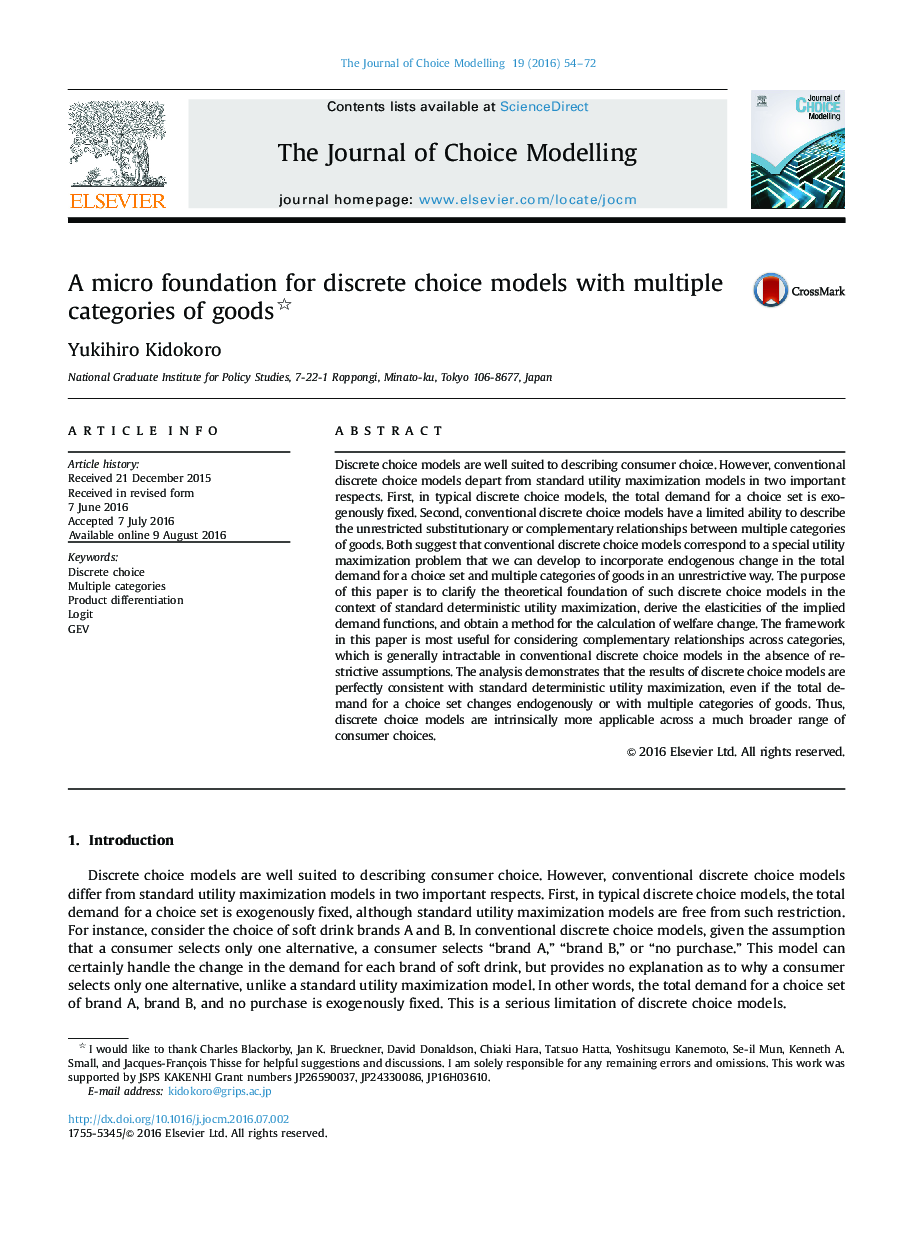| کد مقاله | کد نشریه | سال انتشار | مقاله انگلیسی | نسخه تمام متن |
|---|---|---|---|---|
| 5091821 | 1478395 | 2016 | 19 صفحه PDF | دانلود رایگان |
عنوان انگلیسی مقاله ISI
A micro foundation for discrete choice models with multiple categories of goods
ترجمه فارسی عنوان
یک پایه میکرو برای مدل انتخاب گسسته با دسته بندی های مختلف کالا
دانلود مقاله + سفارش ترجمه
دانلود مقاله ISI انگلیسی
رایگان برای ایرانیان
ترجمه چکیده
مدل انتخابی گسسته برای توصیف انتخاب مصرف کننده مناسب است. با این حال، مدل های انتخابی متداول متداول از مدل های به حداکثر رساندن ابزار استاندارد در دو جنبه مهم جلوگیری می شود. اول، در مدل های انتخابی معمولی انتخاب، تقاضای کل مجموعه ای از انتخاب به طور خارجی ثابت می شود. دوم، مدل های انتخابی متداول گسسته دارای توانایی محدودی برای توصیف روابط نامنظم جایگزین یا مکمل چند دسته بندی کالا هستند. هر دو نشان می دهند که مدل های انتخابی متداول متداول با یک مشکل به حداکثر رساندن ابزار خاص مطابقت دارند که می توان آن را توسعه داد تا تغییرات درونی را در کل تقاضا برای مجموعه انتخابی و دسته بندی های مختلف کالاها به صورت غیر محدود کننده ترکیب کنیم. هدف از این مقاله، روشن ساختن مبانی نظری چنین مدلهای گزینشی گسسته در زمینه به حداکثر رساندن ابزارهای مطلوب قطعی استاندارد، کشف ضریب پذیری توابع تقاضای تقلبی و به دست آوردن روش برای محاسبه تغییر رفاه است. چارچوب در این مقاله بیشتر برای در نظر گرفتن روابط تکمیلی در میان دسته ها است که به طور کلی در مدل های انتخابی متعارف معمول در شرایط عدم وجود فرضیه های محدود کننده قابل حل است. تجزیه و تحلیل نشان می دهد که نتایج مدل های انتخابی گسسته کاملا با حداکثر رساندن قابلیت های قطعی استاندارد مطابقت می کند، حتی اگر تقاضای کل برای یک مجموعه انتخابی درونی یا با دسته های مختلفی از کالاها تغییر کند. بنابراین، مدل های گزینشی گزاره ای در درون محدوده وسیعتری از گزینه های مصرف کننده، به طور ذاتی قابل استفاده هستند.
موضوعات مرتبط
علوم انسانی و اجتماعی
مدیریت، کسب و کار و حسابداری
بازاریابی و مدیریت بازار
چکیده انگلیسی
Discrete choice models are well suited to describing consumer choice. However, conventional discrete choice models depart from standard utility maximization models in two important respects. First, in typical discrete choice models, the total demand for a choice set is exogenously fixed. Second, conventional discrete choice models have a limited ability to describe the unrestricted substitutionary or complementary relationships between multiple categories of goods. Both suggest that conventional discrete choice models correspond to a special utility maximization problem that we can develop to incorporate endogenous change in the total demand for a choice set and multiple categories of goods in an unrestrictive way. The purpose of this paper is to clarify the theoretical foundation of such discrete choice models in the context of standard deterministic utility maximization, derive the elasticities of the implied demand functions, and obtain a method for the calculation of welfare change. The framework in this paper is most useful for considering complementary relationships across categories, which is generally intractable in conventional discrete choice models in the absence of restrictive assumptions. The analysis demonstrates that the results of discrete choice models are perfectly consistent with standard deterministic utility maximization, even if the total demand for a choice set changes endogenously or with multiple categories of goods. Thus, discrete choice models are intrinsically more applicable across a much broader range of consumer choices.
ناشر
Database: Elsevier - ScienceDirect (ساینس دایرکت)
Journal: Journal of Choice Modelling - Volume 19, June 2016, Pages 54-72
Journal: Journal of Choice Modelling - Volume 19, June 2016, Pages 54-72
نویسندگان
Yukihiro Kidokoro,
